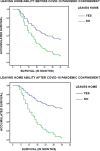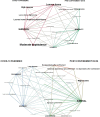Socio-health factors, ability to perform instrumental and basic activities of daily living, and use of assistive mobility devices during the COVID-19 pandemic: Interrelationships and impact on long-term survival
- PMID: 40388524
- PMCID: PMC12088529
- DOI: 10.1371/journal.pone.0318481
Socio-health factors, ability to perform instrumental and basic activities of daily living, and use of assistive mobility devices during the COVID-19 pandemic: Interrelationships and impact on long-term survival
Abstract
Introduction: Functional dependence for the performance of basic activities of daily living (ADLs) is one of the main causes of institutionalization. This study analyzed the interrelationships between basic and instrumental activities of daily living, use of assistive mobility devices, socioeconomic factors, changes during COVID-19 pandemic confinement, and 3-year survival in the ADL-dependent people of the Orcasitas neighborhood of Madrid (Spain).
Methods: A longitudinal descriptive study, carried out on the entire population of functional dependent patients (Barthel ≤ 60) in the Orcasitas neighborhood. We included 127 patients, 78.7% women and 21.3% men, with a mean age of 86 years. Pre-pandemic, post-confinement (June 2020) and June 2023 data were contrasted.
Results: Results: The use of crutches-cane was associated with a higher probability of being independent in performing ADLs, leaving home (OR 4.848; CI 1.428-16.458), improving functional capacity during confinement (OR 3.621; CI 1.409-9.308), and even ceasing to be functionally dependent (OR 0.394; CI 0.165-0.941). Using a wheelchair was associated with a higher level of dependency (OR 2.583; CI 1.167-5.714) and higher mortality (HR 1.913; CI 1.106-3.309). After COVID-19 pandemic confinement, having a financial income of less than 11,200 euros/year (OR 2.413; CI 1.159-5.023), or using a wheelchair (OR 2.464; CI 1.009-6.017), increased the risk of living homebound. Living homebound decreased the probability of survival, while maintaining the ability to leave home increased it (OR 3.880; CI 1.834-8.211). Economic capacity modulated the results. Lower economic capacity was associated with higher mortality (HR 2.47 (Exp(B) 0.405; CI 0.232-0.708). Living in confinement and having a low economic income were associated with higher mortality (OR 0.127; CI 0.029-0.562), mortality that was also higher with respect to those who could leave their home (OR 6.697; CI 2.084-21.525).
Conclusions: Functional ADL-dependence affects multiple facets of the person. Confinement triggered changes in the baseline conditions of this cohort, which were influenced by the level of dependency, mobility capacity and economic income level. Economic capacity modulated the results, showing that social inequalities influence survival. The ability to leave home and the use of a wheelchair should be included in the assessment of the risk level of this population group.
Copyright: © 2025 Martín Moreno et al. This is an open access article distributed under the terms of the Creative Commons Attribution License, which permits unrestricted use, distribution, and reproduction in any medium, provided the original author and source are credited.
Conflict of interest statement
Vicente Martín Moreno. María Inmaculada Martínez Sanz. Irene Sánchez González. Miguel Recuero Vázquez. Sara Guerra Maroto. Miriam Fernández Gallardo. Amanda Martín Fernández. Julia Herránz Hernando. Palma Benítez Calderón. Eva Sevillano Fuentes. Elena Pérez Rico. Laura Calderón Jiménez. Elena Sánchez Rodríguez. Helena Alonso Samperiz. Irene León Saiz. Juana Marcos Guerra.
Figures










Similar articles
-
The care of non-institutionalized ADL-dependent people in the Orcasitas neighborhood of Madrid (Spain) during the Covid-19 pandemic and its relationship with social inequalities, intergenerational dependency and survival.Front Public Health. 2024 Sep 25;12:1411390. doi: 10.3389/fpubh.2024.1411390. eCollection 2024. Front Public Health. 2024. PMID: 39386947 Free PMC article.
-
The influence of nationwide COVID-19 lockdown on the functional impairment and long-term survival of dependent people for carrying out basic activities of daily living in a neighborhood of the city of Madrid, Spain: Orcasitas Cohort Longitudinal Study.Front Public Health. 2024 Jul 9;12:1385058. doi: 10.3389/fpubh.2024.1385058. eCollection 2024. Front Public Health. 2024. PMID: 39045161 Free PMC article.
-
Proposal for a revised Barthel index classification based on mortality risk assessment in functional dependence for basic activities of daily living.Front Public Health. 2025 Jan 14;12:1478897. doi: 10.3389/fpubh.2024.1478897. eCollection 2024. Front Public Health. 2025. PMID: 39877909 Free PMC article.
-
Longitudinal studies of dependence in daily life activities among elderly persons.Scand J Rehabil Med Suppl. 1996;34:1-35. Scand J Rehabil Med Suppl. 1996. PMID: 8701230 Review.
-
Muscle mass, strength, and physical performance predicting activities of daily living: a meta-analysis.J Cachexia Sarcopenia Muscle. 2020 Feb;11(1):3-25. doi: 10.1002/jcsm.12502. Epub 2019 Dec 1. J Cachexia Sarcopenia Muscle. 2020. PMID: 31788969 Free PMC article. Review.
References
-
- Plan de Atención Integral a la Fragilidad y Promoción de la Longevidad Saludable en Personas mayores de la Comunidad de Madrid 2022–5. Consejería de Sanidad. Comunidad de Madrid. 2022. Disponible en: https://gestiona3.madrid.org/bvirtual/BVCM050724.pdf
-
- Luppa M, Riedel-Heller SG, Luck T, Wiese B, van den Bussche H, Haller F, et al.. Age-related predictors of institutionalization: results of the German study on ageing, cognition and dementia in primary care patients (AgeCoDe). Soc Psychiatry Psychiatr Epidemiol. 2012;47(2):263–70. doi: 10.1007/s00127-010-0333-9 - DOI - PubMed
-
- Muyor Rodríguez J. Media framing of the impact of COVID-19 in nursing homes. A content analysis of the identification and management of the problem. Revista Ehquidad. 2021;(15):47–76. doi: 10.15257/ehquidad.2021.0003 - DOI
MeSH terms
LinkOut - more resources
Full Text Sources
Medical

